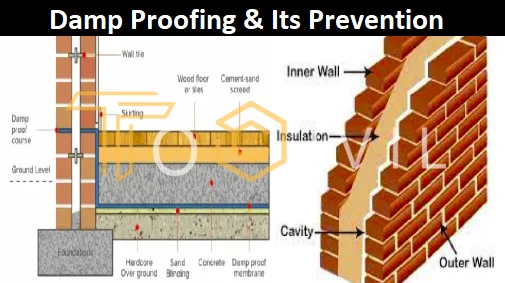Comprehending the Significance of Damp Proofing in Stopping Structural Damages
Damp proofing acts as a crucial protection versus dampness seepage in buildings. This protective measure can stop significant structural damage, yet numerous homeowner continue to be uninformed of its importance. Identifying the indicators of wetness and understanding the various services offered can be imperative. Nonetheless, neglecting damp proofing can cause serious effects. What are the specific threats and solutions that home owners should consider?
What Perspires Proofing and How Does It Work?
Damp proofing functions as an important obstacle versus wetness breach in buildings. damp removal newcastle. This process includes using certain materials and methods to avoid water from penetrating walls, floorings, and various other structural elements. Generally, damp proofing can be achieved via the installation of damp proof membrane layers, coatings, or making use of specialized sealants.These methods work by producing a protective layer that prevents moisture motion, making certain that the indoor environment continues to be completely dry and healthy and balanced. Damp proofing is particularly vital in areas susceptible to high humidity or groundwater, as it helps preserve the stability of the structure over time.Moreover, effective moist proofing adds to power effectiveness by protecting against warm loss connected with moist settings. By attending to potential wetness issues before they intensify, damp proofing acts as a positive procedure in safeguarding buildings from the damaging effects of water damage, inevitably prolonging their life expectancy and keeping their value
Common Indicators of Wetness in a Structure
Dampness problems within a building can manifest with several obvious indicators that suggest the visibility of moisture. One popular indication is the look of water spots on ceilings or walls, which frequently indicates moisture seepage. Furthermore, gurgling or peeling off paint can suggest that excess humidity is entraped beneath the surface area, resulting in deterioration. An additional common sign is the presence of mold and mildew and mildew, which grow in wet conditions and can typically be recognized by their mildewy odor. A rise in moisture degrees can trigger condensation on home windows and other surface areas, highlighting dampness problems. Finally, distorted or irregular floor covering might indicate underlying wetness that jeopardizes architectural honesty. Identifying these indications early can aid alleviate prospective damage and keep a secure living setting. Routine evaluations and prompt action are necessary in dealing with moisture problems prior to they intensify.
The Dangers of Disregarding Damp Proofing
Neglecting moist proofing can bring about significant threats to a structure's structural integrity, as wetness buildup might damage walls and foundations. In addition, prolonged dampness creates a setting conducive to mold and mildew development, positioning significant health hazards to residents. Addressing these threats is necessary for ensuring both security and durability of the building.
Architectural Stability Hazards
When house owners ignore the relevance of reliable wet proofing, they reveal their homes to significant architectural integrity risks. Prolonged wetness seepage can bring about the advancement of mold and mildew, which compromises fundamental elements and can endanger total stability. Additionally, excess moisture can wear down concrete and brickwork, resulting in cracks and architectural failings. Wood components are specifically susceptible; they can rot and lose load-bearing capacity, presenting major threats to the building's framework. In addition, untreated wet problems might draw in pests, such as termites, which even more intensify architectural degeneration. Inevitably, neglecting wet proofing measures can bring about expensive repair services and prospective safety and security threats, emphasizing the essential function of aggressive wet administration in protecting the honesty of homes.
Health And Wellness Risk Worries
Just how can a seemingly small oversight result in significant health and wellness risks? Ignoring wet proofing can create an environment for mold and mildew development, which positions considerable health threats. Mold and mildew spores can cause allergies, respiratory concerns, and other health and wellness problems, particularly in prone populaces such as children, the elderly, and people with pre-existing problems. Additionally, consistent dampness can bring in insects like bugs and rats, which lug conditions that further endanger wellness. The visibility of moisture likewise contributes to a decrease in interior air quality, exacerbating asthma and various other respiratory system conditions. The failing to address moist concerns not just intimidates structural honesty yet also endangers the wellness of passengers, highlighting the vital requirement for effective moist proofing procedures.
Various Kinds of Damp Proofing Solutions
Although different variables can add to damp issues in structures, choosing the proper wet proofing service is vital for preserving architectural stability. Several choices are available, each customized to details conditions.One typical option is a damp-proof membrane (DPM), commonly made of polyethylene or bitumen, which is mounted in walls and floors to protect against dampness ingress. Another choice is damp-proof training courses (DPC), which are layers of water resistant material placed within wall surfaces to block rising damp.Chemical damp proofing entails injecting waterproofing chemicals right into walls to create an obstacle against moisture. In addition, exterior therapies such as tanking, which entails using a water resistant layer to the outside of foundations, can be effective in avoiding water penetration.Each solution has its advantages and is chosen based upon the structure's certain concerns, ecological conditions, and lasting upkeep considerations, making certain ideal protection against damp-related damage.

The Expense of Damp Damage vs. Prevention
Recognizing the monetary ramifications of moist damages compared to prevention highlights the value of proactive measures. The costs connected with wet damages can be significant, consisting of repair services to architectural aspects, mold remediation, and potential health-related expenses. Homeowners might encounter significant monetary strain if considerable damage happens, leading to boosted insurance coverage costs and lost home value.In comparison, buying wet proofing solutions is normally far a lot read more more affordable. Preliminary expenditures for prevention methods, such as enhancing or setting up damp-proof membranes drainage systems, are usually surpassed by the lasting financial savings from staying clear of expensive repairs. In addition, avoiding wet concerns can enhance a building's total value and charm, making it a wise financial investment. When reviewing the price of wet damages versus prevention, it comes to be clear that taking positive actions can guard financial rate of interests and maintain the integrity of the building gradually.
Selecting the Right Damp Proofing Method for Your Building
Which wet proofing method is most appropriate for a certain building frequently depends on various variables, including the building's age, existing moisture concerns, and local ecological problems. For older frameworks, conventional techniques such as asphalt membranes or cementitious coverings may be much more effective, as they can provide a robust barrier against increasing damp. In contrast, more recent structures could profit from contemporary services like injected damp-proof courses, which are less intrusive and can be customized to certain wetness challenges.Additionally, residential properties in areas with high water tables or hefty rains might call for advanced strategies, such as tooth cavity wall surface drain systems or outside waterproofing. Homeowners ought to likewise think about the particular materials made use of in their structure's building and construction, as some techniques may not work. Ultimately, a detailed assessment by an expert can direct property proprietors in picking one of the most efficient wet proofing technique customized to their special situations.
Preserving Your Damp Proofing System Gradually
Normal maintenance of a wet proofing system is necessary for guaranteeing its long-lasting efficiency and safeguarding a home from moisture-related damages. Homeowner must conduct regular assessments to recognize any type of indications of wear or concession in the wet proofing layer. This includes monitoring for splits, peeling paint, or mold growth, which might show moisture intrusion.Additionally, it is recommended to tidy seamless gutters and downspouts regularly to prevent water buildup around the foundation. If damage is observed.Engaging specialist services for periodic analyses can better boost the sturdiness of the system, reapplying membranes or sealers may be necessary. These professionals can give understandings into possible vulnerabilities and suggest timely repair services.
Frequently Asked Inquiries
How Much Time Does Damp Proofing Treatment Last Prior To Needing Repair Work?
The longevity of wet proofing treatment usually ranges from 10 to thirty years, depending on elements such as the method used, ecological conditions, and maintenance methods. Normal assessments can assist determine when repair work might be necessary.
Is DIY Damp Proofing Effective Contrasted to Professional Providers?
The efficiency of DIY damp proofing differs significantly. damp proofing newcastle. While some people may attain acceptable results, specialist services normally assure thorough services, leveraging know-how and top quality materials to avoid future concerns a lot more dependably than many DIY efforts
Can Damp Proofing Improve Indoor Air High Quality?
The inquiry of whether wet proofing can boost indoor air high quality arises regularly. Efficient wet proofing reduces moisture levels, therefore decreasing mold growth and allergens, inevitably adding to a healthier indoor setting for passengers.
Are There Details Rules for Damp Proofing in Different Locations?
Laws for damp proofing differ by region, usually influenced by local building ordinance and environmental conditions. Conformity guarantees efficient dampness control, advertising and securing structures security, which highlights the necessity for adherence to these details laws.

What Are the Long-Term Perks of Correct Damp Proofing?
The lasting benefits of correct wet proofing consist of enhanced architectural integrity, reduced upkeep expenses, boosted indoor air high quality, and increased property value. These benefits add to a healthier living setting and long term lifespan of buildings. Generally, moist proofing can be achieved through the installment of wet proof membranes, coverings, or the use of specialized sealants.These techniques work by creating a protective layer that inhibits dampness activity, making sure that the indoor setting stays healthy and balanced and completely dry. Moist proofing is specifically vital in locations vulnerable to high moisture or groundwater, as it helps preserve the integrity of the structure over time.Moreover, reliable wet proofing adds to power effectiveness by stopping warmth loss associated with wet atmospheres. Disregarding moist proofing can lead to significant risks to a building's architectural honesty, as dampness build-up may damage wall surfaces and foundations (damp specialist newcastle). Numerous elements can contribute to damp issues in structures, picking the ideal wet proofing remedy is crucial for protecting structural honesty. Which damp proofing method is most suitable for a particular property often depends on different aspects, consisting of the structure's age, existing dampness issues, and regional environmental problems
 Josh Saviano Then & Now!
Josh Saviano Then & Now! Mason Gamble Then & Now!
Mason Gamble Then & Now! Keshia Knight Pulliam Then & Now!
Keshia Knight Pulliam Then & Now! Susan Dey Then & Now!
Susan Dey Then & Now! Richard Dean Anderson Then & Now!
Richard Dean Anderson Then & Now!